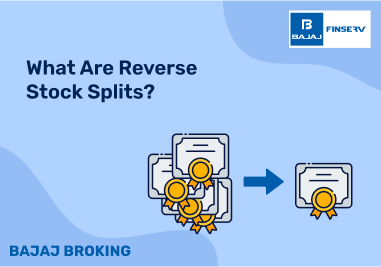How many types of ITR forms are there?
- Answer Field
-
There are 7 types of ITR forms.
BAJAJ BROKING
Filing your income tax return is a crucial process every citizen must follow annually. Though people usually take the help of their chartered accountant or CA to do the job, they need to be aware of the intricacies of the process. Take a look at everything you need to know here.
The main aim of the ITR filing is to let a taxpayer register the total income they have earned in a fiscal year. The ITR filing process is a mandatory duty of a citizen as established under the Income-Tax Act 1961. However, the ITR filing process is not just used to record the total income of an individual.
Even if an individual does not have a total income to show, they could be filing an ITR due to various other reasons. This could include wanting to claim an income tax refund, carry forward losses, availing loans from banks, availing a VISA, etc.
The Income Tax Return (ITR) is a form issued by the Income Tax Department of India. The form is used to record the details of an individual’s, company’s, etc income details. The form also records the tax payable to the Income Tax Department by the applicant. Under the Indian income tax laws, income returns must be filed by every individual and business that is earning an income. The ITR form helps with declaring the taxable income as well as the tax liability, and tax deductions claims, if there are any.
ITR filing can be done easily through the Income Tax Department's official portal. This is the process of E-filing of an ITR and yes it is exactly like it sounds; individuals can simply file their taxes online. The new income tax portal can easily be accessed by an individual by using PAN-based login credentials. With the e-filing process, individuals can also take advantage of many features on the portal that will simplify the process further.
Individuals are expected to file their returns on or before the ITR last date. There are different types of ITR forms to pick from depending on whether the taxpayer is an individual, a company, a HUF (Hindu Undivided Family), etc.
There are a total of seven different types of ITR forms to choose from. These include:
ITR 1
The ITR 1 form is meant for any Individuals residing in India having a total income of up to ₹50 lakh. These individuals can be earning their income through a job, from home, or other sources. Salaried taxpayers can use Form 16 to file their ITRs. NRIs cannot file ITR 1.
ITR 2
Any individuals or HUF who are not eligible to file ITR-1 can file ITR-2. Also, individuals who don’t have income from profit and gains of business or jobs can apply for ITR 2.
ITR 3
Salaried individuals who earn through intraday stock exchange or futures and options trading should file Form ITR-3. Also applicable to individuals and HUFs having gains from business or jobs.
ITR 4
Individuals, HUFs, and partnership companies whose total income is less than ₹2 crore subject to section 44AD taxation and those who are subject to a presumptive taxation system on their earnings can file ITR 4.
ITR 5
Alliance companies like LLPs, partnership companies, AOPs, and BOIs need to file ITR-5 and disclose their profits from their businesses and professions in form. They also need to include as well as some other sources of income.
ITR 6
The ITR 6 form is used by businesses to report their revenue from both industry and occupation. The form should also include income from any other sources as well.
ITR 7
ITR 7 is a federal tax return that is filed by businesses, partnerships, and trusts that are excluded from paying income tax.
Under the old tax regime, individuals below 60 years with an income of more than ₹2.5 lakh have to file an ITR. Under the same regime, individuals 60+ years with more than ₹3 lakh income need to file their ITR.
Under the new tax regime, the tax exemption for individuals below 60 years has been raised to ₹3 lakhs.
To clarify who is expected to file the ITR, below is a full list.
Individuals with a total income of Rs. 5 lakhs or more are required to file an ITR under Section 139 (4B) (ITR 7).
Individuals/HUF who are residents of India with assets outside of the country.
Individuals liable to pay ITR need to provide a notice under Section 11(2) (a) to an income tax office.
Individuals who wish to claim income tax relief under Sections 90 or 90A also need to file for an ITR.
Any citizen of India having signing authority over account(s) being held outside of India.
Any and every kind of business.
Any individual who is obliged under sections 10(23C) (IV), 10(23C) (v), 10(23C) (VI), 10(23C) (via), 10A, 12A (1) (b), 44AB, 80IA, 80IB, 80IC, 80ID, 80JJAA, 80LA, 92E, or 115JB of the Income Tax Act, to provide an audit report to the authorities.
AOP, BOI, Local Authority (ITR 5), Artificial Juridical Person, or Cooperative Society that does not fall under the terms of Section 44AB
There are two ways through which individuals, businesses and HUFs can file their ITR; the online and the offline method. Here’s a look at both of them.
Online Mode
Income tax returns filing can easily be done online in the following way:
The first step is determining the income tax liability that an individual, company or HUF holds.
The next is to visit the official income tax department portal to e-filing the income tax.
After this, the applicants need to fill out all the required details in the ITR form, which needs to be chosen according to the details listed above. If an applicant is confused, they can also take the help of a CA
The applicant will also be asked to upload the necessary documents if needed,
Once all the details have been confirmed, the filing is validated.
Offline Mode
Other than the online ITR filing method, applicants can also file an ITR. Here are the steps:
Individuals need to first visit the official portal of the Income Tax Department for income tax e-filing
On this portal, individuals need to redirect to the IT Return Preparation Software section
Proceed to download the relevant ITR form.
Next, individuals need to open the downloaded form on the device of their choice and fill in the necessary details.
Next, applicants need to fill in all the necessary details and gather all the required documents. This could include forms like Form 16, Form 26AS, TDS certificates etc.
After this, applicants need to generate a JSON file of the ITR form and save it.
To finish the offline filing process, the applicants need to upload the JSON file.
Most of the time the last date to file Income Tax Returns (ITR) without late fees, is 31st July of the year. If in case an applicant misses out on filing their taxes before the due date, a belated return can also be filed by December 31 of the year. This, however, might invite penalties and interest charges for an applicant.
Applicants are liable to pay a late fee of up to ₹5,000 if their annual income is more than ₹5 lakh. This penalty amount can also go up to ₹10,000 if an individual decides to file income tax returns after the deadline has been crossed.
It is a non-negotiable for Indian citizens to file their ITR on their income to the Government of India. This is a mandate that has been put in place under the rules and regulations of the Income Tax Act 1961. This rule applies to all individuals, associations or firms, LLPs, local authorities and HUFs.
Disclaimer: Investments in the securities market are subject to market risk, read all related documents carefully before investing. This content is for educational purposes only. Securities quoted are exemplary and not recommendatory.
For All Disclaimers Click Here: https://bit.ly/3Tcsfuc
Share this article:

Godrej Properties Acquires 53-Acre Land in Kolkata for ₹500 Crore
21 Nov, 2024 | 2 Min. read

GNFC Partners with INEOS to Build 600kt Acetic Acid Plant in Gujarat
21 Nov, 2024 | 2 Min. read

Adani Infra Launches Open Offer to Buy 26% Stake in PSP Projects
21 Nov, 2024 | 2 Min. read

UPL’s Advanta Secures $350M Investment from Alpha Wave Global
21 Nov, 2024 | 2 Min. read

Commodities Market Today | Crude Oil Drops, Gold Rises, Silver Falls in Market Moves
21 Nov, 2024 | 1 Min. read

Share Market Today | Gift Nifty Signals Weak Opening, Indian Markets May Consolidate
21 Nov, 2024 | 4 Min. read

Gold Rate Today | Gold Gains 0.9% to $2,653.50, Silver Drops 1%
21 Nov, 2024 | 2 Min. read

Know C2C Advanced Systems IPO Review, Objective & Applying Process
21 Nov, 2024 | 1 Min. read

Explore the List of Top Education Stocks in India
21 Nov, 2024 | 8 Min. read

What are Reverse Stock Splits: Meaning & Example
21 Nov, 2024 | 7 Min. read

How to Apply Under Shareholders' Quota in NTPC Green Energy IPO?
21 Nov, 2024 | 1 Min. read

What is Personal Finance? Meaning & Importance
21 Nov, 2024 | 4 Min. read

RBI Launches ULI: Transforming Loan Access
August 27, 2024 | 4 Min. read

Textile Sector in India
September 20, 2024 | 5 Min. read

List of IPOs with DRHPs Filed
November 30, 2023 | 3 Min. read

Aditya Birla Group
September 28, 2023 | 10 Min. read

Bajaj Housing Finance Ltd IPO: Things Smart Investors Need to Know
September 05, 2024 | 4 Min. read

Budget Stock Ideas 2024-2025 | Stocks to Buy Today
July 24, 2024 | 4 Min. read

IPO Eligibility Criteria : Full Details
March 15, 2024 | 6 Min. read

What Is the Lock-In Period in IPOs?
October 18, 2023 | 6 Min. read

Godfrey Phillips Announces 2:1 Bonus Shares
September 16, 2024 | 7 Min. read

Jindal Group- A Comprehensive Analysis
September 27, 2024 | 7 Min. read
There are 7 types of ITR forms.
There are predefined rules according to which an individual, company or HUF needs to select the ITR form they need to fill out.
You can easily track your ITR status from the official portal of the Income Tax Department.
You can start filing your income tax return from the 1st of April every year.
No Result Found
Level up your stock market experience: Download the Bajaj Broking App for effortless investing and trading
